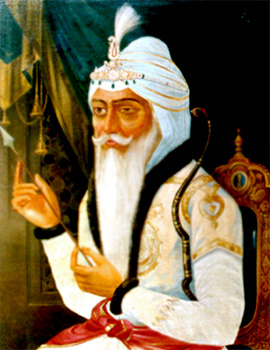 The Sikh Army after Maharaja Ranjit Singh faced several setbacks. The strong edifice built by Maharaja Ranjit Singh was left at his death in 1839 with no capable rulers or successors. A strong rule in the East has mostly been followed by a period of uncertainty, unrest, palace intrigues and even murders. The same happened when Ranjit Singh died leaving an efficient army that was proud of its record and contributions to the Khalsa - the first Sikh empire. His immediate successor Kharak Singh was a weak person. Nao Nihal Singh was supposed to take control of the affairs of the state in a proper manner after the death of his father. Kharak Singh died on 5th of November, 1840 and Nao Nihal Singh also died on the same day as a result of an accident. Sher Singh, another son of Ranjit Singh was then put on the throne, with the help of the army and the Jammu rajas.
The Sikh Army after Maharaja Ranjit Singh faced several setbacks. The strong edifice built by Maharaja Ranjit Singh was left at his death in 1839 with no capable rulers or successors. A strong rule in the East has mostly been followed by a period of uncertainty, unrest, palace intrigues and even murders. The same happened when Ranjit Singh died leaving an efficient army that was proud of its record and contributions to the Khalsa - the first Sikh empire. His immediate successor Kharak Singh was a weak person. Nao Nihal Singh was supposed to take control of the affairs of the state in a proper manner after the death of his father. Kharak Singh died on 5th of November, 1840 and Nao Nihal Singh also died on the same day as a result of an accident. Sher Singh, another son of Ranjit Singh was then put on the throne, with the help of the army and the Jammu rajas.
Palace disorders and deaths continued and the legacy of Maharaja Ranjit Singh was put to a severe test. At the time of his death Maharaja Ranjit Singh left 50,000 well disciplined soldiers, 50,000 properly armed militia and irregular force besides 500 guns. The army became unruly and ceased to be the willing instrument of the Lahore Darbar. Sher Singh was murdered in 1843 and Dalip Singh, another son of Ranjit Singh was placed on the throne after a period of uncertainty in which a number of persons lost their lives.
During this period of constant intrigues the army gave the Government a semblance of strength and solidarity. Its share in these disorders was no less. With the panchayats the army took its own decisions and also enforced them. Thus it became, more or less, the king-maker. None dared to raise a finger against the decisions taken by the army. On the other hand, each one of the new arrivals wanted to propitiate and win its favour. Earlier, in 1843, the panchayats would not allow the move of any army unit out of Lahore without satisfying themselves of the necessity of the measure, as they felt that the Darbar planned to weaken their authority by dispersing the regiments all over the kingdom. These regimental panchayats were nothing new to the soldiers who all came from the villages. Five representatives or panch were selected from each battalion. This was done on the basis of their influence that they commanded in their villages. A combination of those panchayats decided the issue. These, however, did not interfere with the discipline or training.






































